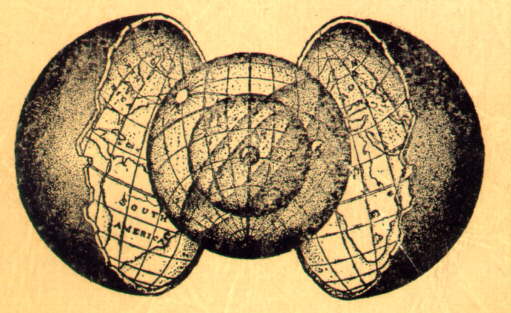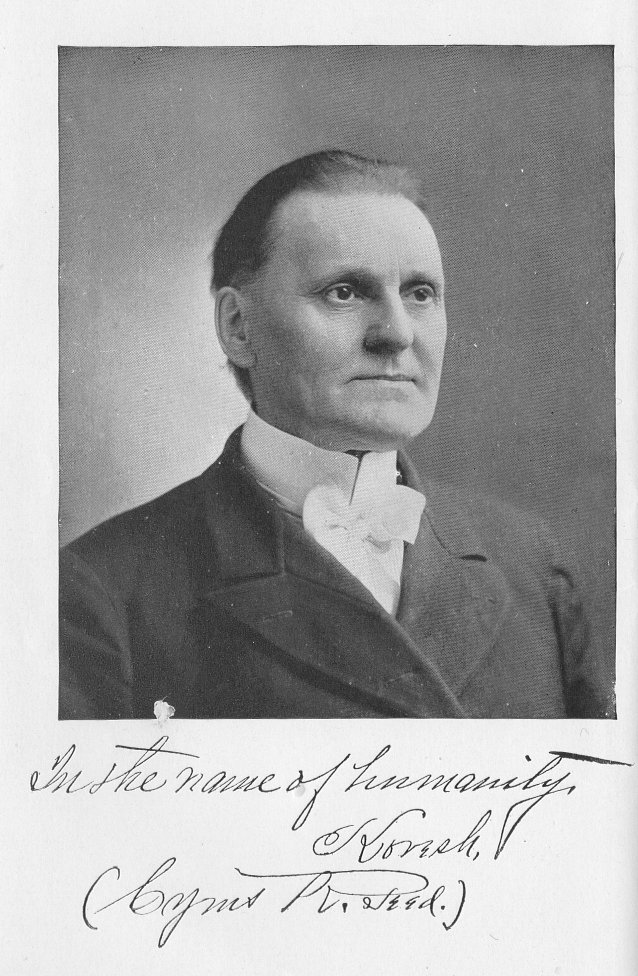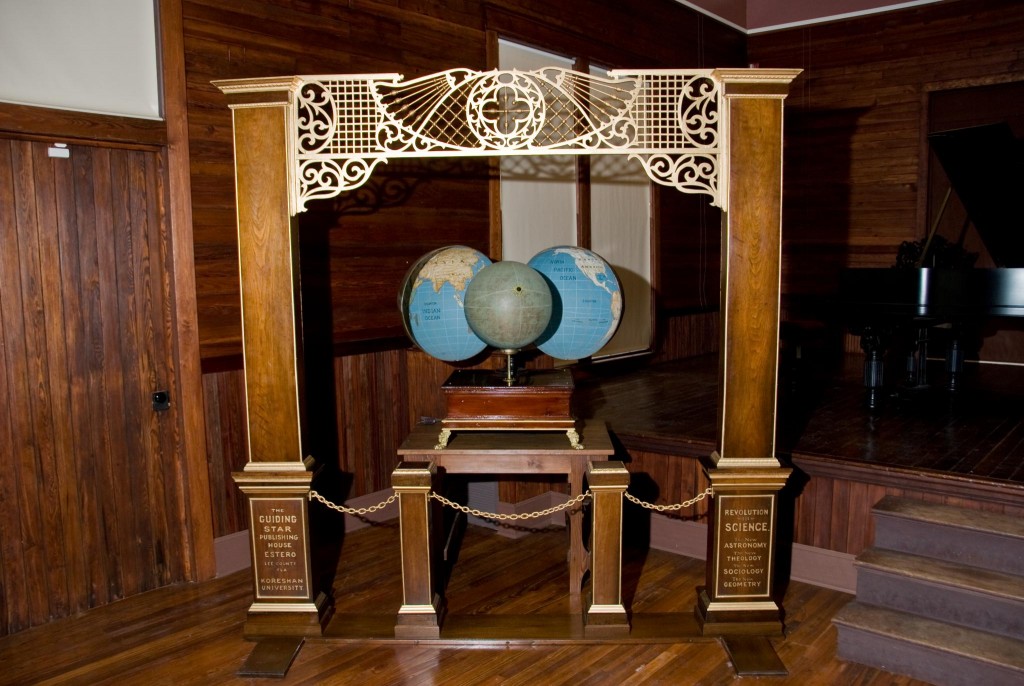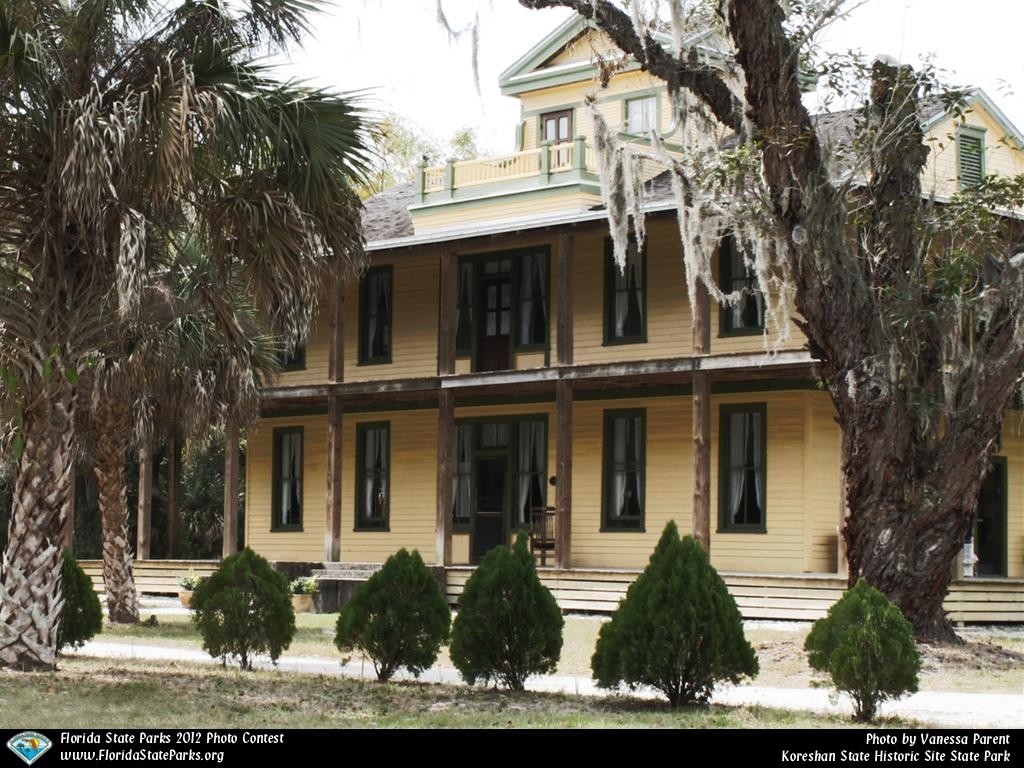You Live in Pellucidar: The Weird Inner World of Cyrus Teed and the Koreshan Unity
 When Edgar Rice Burroughs wrote At the Earth’s Core (1914) and Pellucidar (1915), he brought to a summit the previous century’s passion to explore the fantastic possibilities of what lies below the crust of the Earth. Numerous Victorian scientific romances arose from these theories about the interior of the planet. It’s only natural that once you state, “The world is round,” you follow up with, “Yeah, but what’s inside it?”
When Edgar Rice Burroughs wrote At the Earth’s Core (1914) and Pellucidar (1915), he brought to a summit the previous century’s passion to explore the fantastic possibilities of what lies below the crust of the Earth. Numerous Victorian scientific romances arose from these theories about the interior of the planet. It’s only natural that once you state, “The world is round,” you follow up with, “Yeah, but what’s inside it?”
A man named Cyrus R. Teed provided perhaps the strangest answer of all: “You.”
Cyrus Teed, his theory of Cellular Cosmogony, and the utopian religious commune movement that arose from it are among the most beguiling offshoots of hollow earth theories. They’re also a peculiar parallel with Burroughs’s fantastic adventure tales. Cyrus Teed believed in a concave inner world with the sun at its center, similar to the popular theory of John Cleves Symmes. But for Teed there was no reason to search for an entrance to the Earth’s interior, because the human race was already living in it. In other words, Pellucidar is real, and it’s your home.
The tale of Cyrus Teed and the Koreshan Unity is a curious historical footnote. But it has intriguing things to say to readers of fantasy and science fiction, as well as to historians interested in the utopian communes that ballooned and popped across the U.S. in the nineteenth century. Edgar Rice Burroughs certainly knew about it, since after writing At the Earth’s Core he kept notes on different hollow earth theories. (The fictional ERB even mentions this in Tanar of Pellucidar.) His curiosity is easy to understand, especially when it leads to discovering something like this…
Cyrus “Koresh” Teed, Doctor of Eclectic Medicine
Cyrus Reed Teed was born in Delaware County, NY, in October 1839. He studied medicine and opened his own practice in Utica, NY, before his life took a sharp swerve away from the conventional. He became a doctor in the field of “Eclectic Medicine,” which meant he did whatever he believed might help a patient, even if there was zero medical evidence to support it. This was an actual school of thought at the time, and certainly not the oddest one of the century. Teed would soon travel to far stranger fields of the mind.
 In 1869, Teed had his Road to Damascus moment. He later described this epiphany as an “illumination” in which the female half of the godhead unveiled to him the true nature of the universe that went against all norms of accepted reality. The godhead commanded Teed to take this knowledge to the world and preach as a new messiah.
In 1869, Teed had his Road to Damascus moment. He later described this epiphany as an “illumination” in which the female half of the godhead unveiled to him the true nature of the universe that went against all norms of accepted reality. The godhead commanded Teed to take this knowledge to the world and preach as a new messiah.
The next year Teed left his Shaker community to found his own religious group in Chicago. He renamed himself “Koresh,” the Hebrew version of Cyrus, which means “shepherd.” He called his new religion “Koreshanity” and his followers “The Koreshan Unity.” The religious principles he preached were adapted from Shaker ideas, sprinkled with his own interests: immortality, reincarnation, celibacy except for procreation, collectivism, and alchemy. Koreshanity attracted a steady stream of followers over the next twenty-four years. Separate Koreshan communities were founded around the country; by the early 1890s, Teed claimed to have four thousand adherents.
So far this sounds like the standard path for a nineteenth-century utopian group. But that’s before taking a look at the conception of the universe that started it all: what Teed called “Cellular Cosmogony.”
Drilling to the Core of Cellular Cosmogony
Teed explicated his theory in the 1897 book The Cellular Cosmogony, or, The Earth a Concave Sphere. A summation from the introduction:
THE AUTHOR of the Koreshan System of Universology (upon the basis of the law of comparative analogy) announced, in 1870, the discovery of the cosmogonic form, which he then declared to be cellular; the surface of the earth being concave, with a curvature of about eight inches to the mile. This rate of curvation would give a diameter of eight thousand, and a circumference of twenty-five thousand miles.
I’ve referred to Cellular Cosmogony as a hollow earth theory, but it’s broader than that. It encompasses the entire universe within the rock shell of Earth. (As to what’s outside this cell, Teed never explained.) This hollow cell is 8,000 miles in diameter with a circumference of 25,000 miles. Humans live on the concave inner surface, heads pointing toward the center. Within the cell are three nested atmosphere shells and the sun at the middle.
However, what we see in the sky isn’t the actual sun. The sun is an electromagnetic battery that’s invisible to direct sight. The sun’s rays bend by refraction — all light rays inside the earth cell travel on curved paths toward the ground — and we see the second “focalization” of the sun at the top of the atmosphere.
What about day and night? The sun is dark on one half, light on the other, and its rotation creates the illusion of sunrise and sunsets. (But what about the sun’s movements across the sky? Ah, that’s those curving light rays at work causing the visual deception of movement!) The energy that comes from the dark side of the sun emits light from multiple points that focalize into stars.
There is much, much more in the few hundred pages of Cellular Cosmogony. Teed made an attempt to explain everything he possibly could using the cellular model, such as nebulas, comets, and rainbows, while simultaneously dismissing contrary observations:
Applying the common laws and principles of optics, with perspective foreshortening, all the phenomena of appearances in optical illusion were scientifically accounted for, and the earth optically demonstrated to be concave, although visual appearances seemed to indicate the contrary.
Even the crudest science of the 1890s can crack Teed’s model to shards. The questions just pour out: Why is there a horizon that seems to be about five miles away? Why can’t I see San Diego from my house if it’s curving upward? What is the moon? And what about gravity? What’s sticking us to the concave surface, and wouldn’t the sun draw us upward?
 Teed attempted to provide answers to anticipated questions. This involved some creative tap-dancing; i.e. making things up. To refute the gravity problem, he invented “gravic rays” emanating from the sun that hold people to the ground. The moon is yet another focalization, except it’s more like an X-ray of all the geologic strata in the crust of the earth.
Teed attempted to provide answers to anticipated questions. This involved some creative tap-dancing; i.e. making things up. To refute the gravity problem, he invented “gravic rays” emanating from the sun that hold people to the ground. The moon is yet another focalization, except it’s more like an X-ray of all the geologic strata in the crust of the earth.
Despite all of Cyrus Teed’s scientific-sounding hocus pocus to explain his mash-up of Symmes’s hollow earth theory with aspects of zetetic (flat earth) theories, he wasn’t interested in actual science. For Cellular Cosmogony to work required a complete rejection of the scientific method, Copernicus, Newton, atomic theory, chemistry, optics, surveying … everything, really. Teed’s opinion of Copernicus was indeed low; he claimed that the Copernican system “does not contain a single positive proof of scientific accuracy.”
Teed was actually promoting Koreshanity, a messianic religion:
If we accept the logical deduction of the fallacious Copernican system of astronomy, we conclude the universe to be illimitable and incomprehensible, and its cause equally so; therefore, not only would the universe be forever beyond the reach of the intellectual perspective of human aspiration and effort, but God himself would be beyond the pale of our conception, and therefore beyond our adoration.
The Koreshan Cosmogony reduces the universe to Proportionate limits, and its cause within the comprehension of the human mind. It demonstrates the possibility of the attainment of man to his supreme inheritance, the ultimate dominion of the universe, thus restoring him to the acme of exaltation, — the throne of the Eternal, whence he had his origin.
This is the core of why Teed’s model of the universe appealed to the small and dedicated number of people in the Koreshan Unity. People terrified at the vastness of space could instead enclose the universe within comprehensible limits. All of creation exists in a small space, cozily cupped in the hands of the deity. And the deity could then be known and properly adored, and humans could again be the center of creation.
Cyrus Teed wasn’t alone in the evolution of his universe model. Cellular Cosmogony had an uncredited co-writer, Ulysses Grant Morrow. Born in Kentucky in 1864, Morrow edited a few small newspapers and taught business shorthand courses before discovering Koreshanity. He became the editor of the Koreshan newspaper, The Flaming Sword, in 1895. A significant part of Cellular Cosmogony was written by Morrow because he was a more talented author than Teed. His skill as an inventor later made him valuable in Teed’s attempt to prove his theories accurate.
The Koreshan Unity in Florida
We’re accustomed to thinking of agrarian communes in the U.S. as something that occurred as part of counterculture movements in the 1960s and ‘70s. But the nineteenth century was the peak of utopian communes in America: the Raritarian Bay Union of New Jersey, Shalam Colony in New Mexico, Prairie Home Community in Ohio, Hopedale Community in Massachusetts, and dozens of others rose and fell across the country during the century. Most were religious-based, embracing transcendentalism and spiritualism, and were founded under charismatic leaders preaching high moral ideals. The Koreshan Unity followed in this tradition.

In 1894, the Koreshan communities in Chicago and San Francisco moved to 305 acres of land near Estero, FL, to create a utopian settlement. Teed believed this spot was near the vital point of the inner surface of the Earth (“the vitellus of the great cosmogonic egg”) and predicted the community would become the “New Jerusalem.” He anticipated eight million arrivals, but at its height the Florida commune only had around 250 of the faithful.
On their Florida land, the Koreshans built a printing facility for their newspaper, a dining hall, a post office, boat works, cement works, a sawmill, a bakery, a general store, and a hostelry. The daily affairs of the settlement were run by a council of women called the Seven Sisters, who lived in a building known as the Planetary Court — which looks eerily like the Haunted Mansion at Disneyland. The Koreshans entered into local politics and unsuccessfully ran candidates for a few government offices.
Even though Teed hurled out science to create the theory of Cellular Cosmogony, he pressed forward with experiments to show scientific proof of the concavity of the Earth. He assigned Ulysses Morrow the job of finding that proof. Morrow invented a device called a rectilineator (a twelve-foot long mahogany and brass structure) to make observations along straight lines over long distances. He did measurements along the water surface of the Gulf Coast of Florida near Naples in 1897 along with the “Koreshan Geodetic staff” from the commune. The experiment returned results that seemed to indicate an upward curve of the ground, but this was either a flaw in the rectilineator’s sagging design, expectation bias, Morrow fudging the figures, or all of the above.
Teed wrote another book in 1902 that expanded past his universe model to his higher messianic promises. The Immortal Manhood: The Laws and Processes of Its Attainment in the Flesh advanced the “theocrasis of Cyrus the Anointed,” through which “thousands will then be dissolved.” What is “theocrasis”? Teed defined it as “the incorruptible dissolution of the physical body by electromagnetic combustion.” This was his promise to his followers upon his death: achievement of immortality through electromagnetic combustion.
The End of New Jerusalem
Although the Koreshan commune was small, it thrived for around a decade, longer than many better-known utopian communes like Brook Farm in Massachusetts, which lasted only seven years. But the Koreshan community faced a major problem as a nineteenth-century utopian commune, which was that it was founded right before the start of the twentieth century. With the commune movement itself withering, the Koreshans didn’t have an extended lease.
The decline set in around 1904. Ulysses Morrow left the community over disagreements with Teed, first to meet up with other hollow earth groups in Germany and Argentina, and then to work as a typesetter until his death in 1950. The same year that Morrow departed, Teed sustained serious injuries trying to break up a brawl between some Koreshans and residents of Fort Myers, FL. The local sheriff pistol-whipped Teed, and he never recovered from his injuries. He died in December 1908. His followers laid his body out in hope for his resurrection, but the county health officer ordered them to bury Teed a few days later.

With Cyrus Teed gone and no electromagnetic combustion happening, the Koreshan Unity started to evaporate, although the land remained in their possession for decades. The Flaming Sword continued to publish until 1949, without acknowledging its founder’s death. But by 1961 there were only four remaining Koreshans. They deeded the 305 acres of the settlement to the State of Florida, and it was converted into a state park. Today the Koreshan Unity Settlement Historic District is on the National Register of Historic Places. There are eleven original structures remaining, including the spooky Planetary Court, laid out across a lushly landscaped area that attracts hikers, campers, and canoers. You can take a trip there if you want to see the only remaining rectilineator.
From Cellular Cosmogony to Pellucidar
Cyrus Teed and Cellular Cosmogony have another legacy aside from the Floridian paradise they left behind. Fringe theories have an unusual power: they may fall from favor and land in the history books, but they never permanently perish. Their traces linger on and go through their own evolutions, appearing in different forms, most often in fiction, and appealing to thinkers and explorers of the strange corners of the human creative drive. Fictional versions of the concept of an enclosed universe have their own place in literature, film, and television. The most prominent pop culture example is the third season Star Trek episode “For the World Is Hollow and I Have Touched the Sky.”
This is where I loop back to my starting point: Edgar Rice Burroughs and Pellucidar. Without my interest in Burroughs, I would never have learned about this strange world around Cyrus Teed. It’s detours like this that are among the reasons I find studying ERB such a rewarding pastime. His work constantly opens new doors to history, science, genre, and theory.
At the Earth’s Core did not emerge from Cellular Cosmogony but from John Cleves Symmes’s hollow earth theory that also influenced Teed. Burroughs almost certainly came across Teed’s ideas later, when he started to collect various hollow earth theories. There’s a startling parallel between the opening chapter of Pellucidar, the second book of the series, and Teed’s view of the universe — except that Burroughs flips Cellular Cosmogony around. David Innes has returned to the inner world and brought with him one of its inhabitants, a female Mahar. He watches her and contemplates what might be going through her reptilian mind:
Her kind believed that in the center of all-pervading solidity there was a single, vast, spherical cavity, which was Pellucidar. This cavity had been left there for the sole purpose of providing a place for the creation and propagation of the Mahar race. Everything within it had been put there for the uses of the Mahar.
I wondered what this particular Mahar might think now. I found pleasure in speculating upon just what the effect had been upon her of passing through the earth’s crust, and coming out into a world that one of even less intelligence than the great Mahars could easily see was a different world from her own Pellucidar.
What had she thought of the outer world’s tiny sun?
What had been the effect upon her of the moon and myriad stars of the clear African nights?
How had she explained them?
With what sensations of awe must she first have watched the sun moving slowly across the heavens to disappear at last beneath the western horizon, leaving in his wake that which the Mahar had never before witnessed — the darkness of night? For upon Pellucidar there is no night. The stationary sun hangs forever in the center of the Pellucidarian sky — directly overhead.
For a moment, Innes considers shooting the Mahar as she starts to make an escape. But he stops himself, choosing instead to let her take back the truth — the revelation of “Convex Cosmogony” — to her race: “I watched her until the distant haze enveloped her and she had disappeared. I was alone.”
And so I watch Cyrus Teed and Cellular Cosmogony fly off into the distant historical haze, leaving me in the company of Edgar Rice Burroughs at the earth’s core. I like it here. There are dinosaurs.
Ryan Harvey is one of the original bloggers for Black Gate, starting in 2008. He received the Writers of the Future Award for his short story “An Acolyte of Black Spires,” and his stories “The Sorrowless Thief” and “Stand at Dubun-Geb” are available in Black Gate online fiction. A further Ahn-Tarqa adventure, “Farewell to Tyrn”, is currently available as an e-book. Ryan lives in Costa Mesa, California where he works as a professional writer for a marketing company. Occasionally, people ask him to talk about Godzilla on interviews.
This is fascinating – thank you.
As someone who once belonged to a tiny religious sect in which alternate scientific theories were propounded by the leaders, and who ultimately did a 180 and ended up with a doctorate in math, I’m fascinated by the mind-set that makes such a scientific “closed universe” – in which every detail is explained and every objection explained away by some simple principle – attractive to its adherents.
I remember a pastor (a “facilitator,” I think we called him) telling me that the Big Bang posits that the universe began as a spinning atom. Nothing spinning counterclockwise could turn around on its own and start spinning clockwise, he said. That would disobey the laws of thermodynamics. But some planets spin CCW and others spin CW. Ergo, the Big Bang theory is false. What if a few planets just got turned upside-down? Apparently, this had never occurred to him. But perhaps I shouldn’t be too hard on him. Orientation is hard. I know, because I once wasted a year of my dissertation work stuck on a minus sign. Finally gave up and found a new project. Both were motivated by string theory, which I sometimes suspect is another hollow earth theory, but don’t tell anyone I said that.
It’s interesting to me how many great scientists of history have veered into what we would call pseudoscience or, at best, highly implausible speculation. Kepler’s Mysterium Cosmographicum comes to mind. What separates them from people like Teed? A lot, I think. Listing the differences is an interesting exercise.
My main problem with Teed’s theory is that, if we’re already living inside the earth, then there aren’t dinosaurs and giant mushroom forests underground, which is plainly false.
I believe the group needs a revival